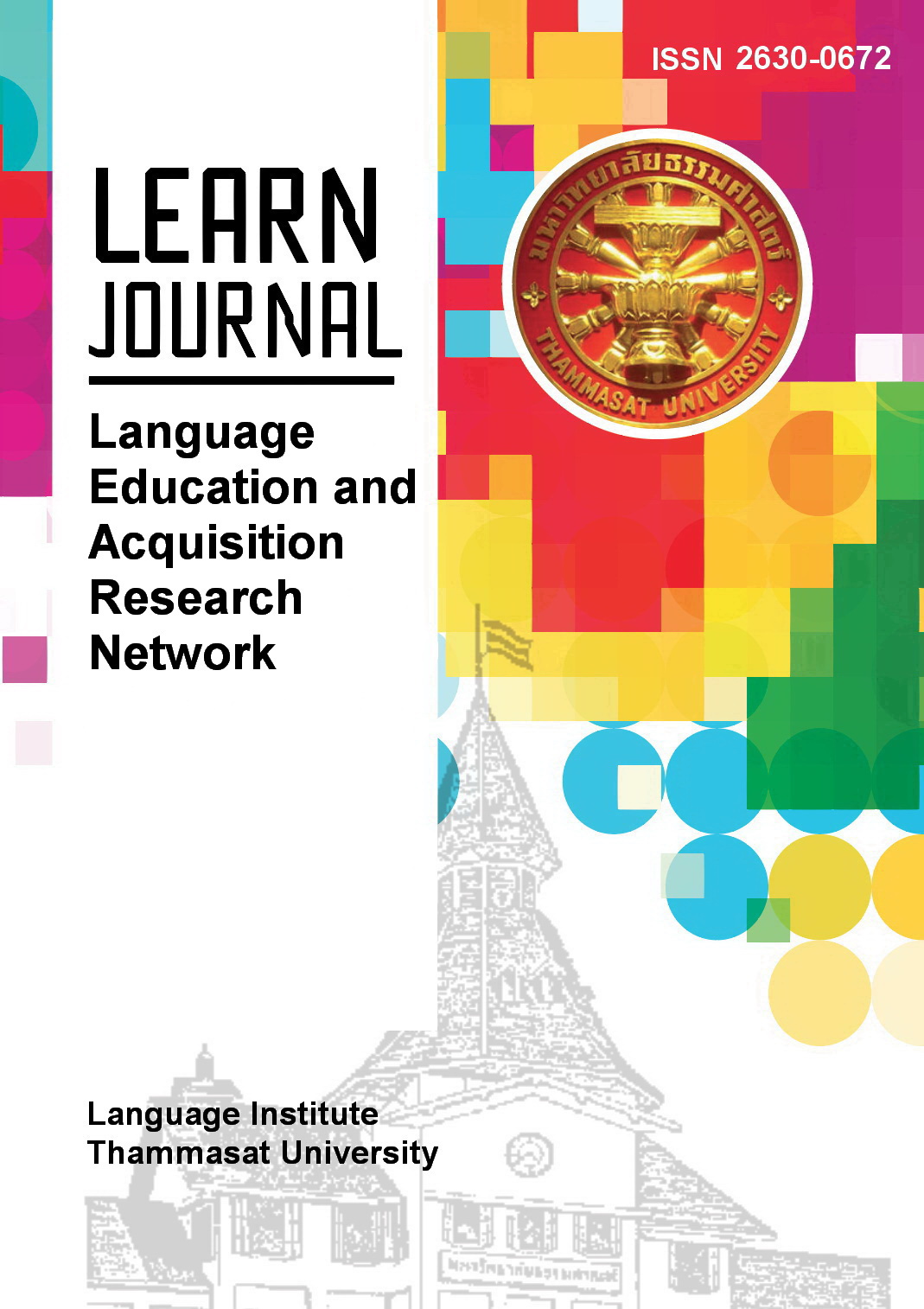Systematicity of L2 Interlanguage of Stress Assignment in English Compound Nouns and Phrasal Verbs by L1 Thai Learners
Main Article Content
Abstract
This study aimed to investigate the production of stress in English compound nouns and phrasal verbs by L1 Thai learners. Based on the Interlanguage Hypothesis (Corder, 1982; Selinker, 1972), it was hypothesized that (1) there is a positive relationship between English proficiency levels and accuracy in stress assignment in compound nouns and phrasal verbs; and (2) L1 Thai learners’ systematicity of L2 English stress placement is influenced by L1 transfer. The participants were 60 first-year undergraduates who were equally divided into two groups, namely intermediate and advanced groups, based on their English proficiency levels. All the participants were required to read sentences containing three different types of compound nouns in the first task and read sentences containing compound nouns and their corresponding phrasal verbs in the second task. Their readings were analyzed using an independent-samples t-test and ANOVA. Although the advanced learners outperformed their intermediate counterparts in assigning stress in both tasks, the statistical results indicated a correlation between English proficiency levels and accuracy in stress placement only in compound nouns, but not in phrasal verbs. It was assumed that such systematicity found in the learners’ IL resulted from the interlanguage factor of language transfer.
Article Details
References
Aarts, B., Chalker, S., & Weiner, E. (2014). The Oxford dictionary of English grammar. Oxford University Press.
Arienintya, D. (2017). The influence of L1 and L2 in English stress shift production of the EFL learners in Indonesia. The 4th International Conference on Language, Society and Culture in Asian Contexts, 482-488. https://doi.org10.18502/kss.v1i3.770
Brinton, L. J. (2000). The structure of modern English: A linguistic introduction. John Benjamins Publishing Company.
Celce-Murcia, M., Brinton, D., Goodwin, J. M., & Griner, B. (2016). Teaching pronunciation: A course book and reference guide (2nd ed.). Cambridge University Press.
Chulalongkorn University Academic Testing Center (n.d.). CU-TEP scores and CEFR levels. http://www.atc.chula.ac.th/pdf2017/Score_CEFR.pdf
Collins. (2021). Compound nouns. In Collins Easy Learning Grammar. Retrieved May 10, 2021, from https://grammar.collinsdictionary.
com/easy-learning/compound-nouns
Collins, B., Mees, I. M., & Carley, P. (2019). Practical English phonetics and phonology: A resource book for students. Routledge.
Corder, S. P. (1982). Error analysis and interlanguage. Oxford University Press.
DeCapua, A. (2017). Grammar for teachers: A guide to American English for native and non-native speakers. Springer International Publishing.
ETS. (2021). Comparing scores. https://www.ets.org/toefl/score-users/scores-admissions/compare
Fraser, H. (2001). Teaching pronunciation: A handbook for teachers and trainers. Three frameworks for an integrated approach. Department of Education Training and Youth Affairs.
Hall, C., & Hastings, C. (2017). Phonetics, phonology & pronunciation for the language classroom. Palgrave Macmillan.
IETLS. (n.d.). Comparing IELTS and the common European Framework. https://www.ielts.org/-/media/pdfs/comparing-ielts-and-cefr.ashx
Isarankura, S. (2016). Effects of stress patterns and tones on stress placement in English polysyllabic loanwords among Thai students in an English major program. Dhurakij Pundit University.
Isarankura, S. (2018). The Effects of stress and tones in Thai on the pronunciation of English polysyllabic loanwords among Thai EFL students. Language Education and Acquisition Research Network (LEARN) Journal, 11(2), 66-83.
Jaiprasong, S., & Pongpairoj, N. (2020). L2 production of English word stress by L1 Thai learners. LEARN Journal, 13(2), 142-157.
Karjo, C. H. (2016). Accounting for L2 learners’ errors in word stress placement. Indonesian Journal of Applied Linguistics, 5(2), 199-208.
Khamkhien, A. (2010). Thai learners’ English pronunciation: Lesson learned from word stress assignment. Journal of Language Teaching and Research, 1(6), 757-764.
Liu, D. (2017). The acquisition of English word stress by Mandarin EFL learners. English Language Teaching, 10(12), 196-201.
Luksaneeyanawin, S. (1983). Intonation in Thai. [Doctoral dissertation, University of Edinburgh]. Edinburg Research Archive.
McArthur, T., Lam-McArthur, J., Fontaine, L., & McArthur, R. (2018). The Oxford companion to the English language. Oxford University Press.
Nguyễn, AT.T., & Đào, Đ.M. (2018). The acquisition of question intonation by Vietnamese learners of English. Asian-Pacific Journal of Second and Foreign Language Education, 3(3), 1-13. https://doi.org/10.1186/s40862-018-0044-4
Pakjamsai, J., & Pongpairoj, N. (2018). The effectiveness of explicit and implicit instruction of L2 English word stress among L1 Thai learners. Thoughts, 1, 1-28.
Peyasantiwong, P. (1986). Stress in Thai. In R.J. Bickner et al. (Eds.), A Conference on Thai Studies in Honor of William J. Gedney (pp. 211-230). Center for South and Southeast Asian studies, the University of Michigan.
Porzuczek, A., & Rojczyk, A. (2017). English word stress in Polish learners’ speech production and metacompetence. Research in Language, 15(4), 313-323.
R Core Team (2020). R: A language and environment for statistical computing. R Foundation for Statistical Computing, Vienna, Austria. https://www.R-project.org/.
Roach, P. (2000). English phonetics and phonology: A practical course. Cambridge University Press.
Rovinelli, R. J., & Hambleton, R. K. (1977). On the use of content specialists in the assessment of criterion-referenced test item validity. Dutch Journal of Educational Research, 2, 49-60.
Sahatsathatsana, S. (2017). Pronunciation problems of Thai students learning English phonetics: A case study at Kalasin University. Journal of Education, 11(4), 67-84.
Selinker, L. (1972). Interlanguage. International Review of Applied Linguistics in Language Teaching, 10, 209-241.
Tuan, D. M. (2018). English lexical stress assignment by EFL learners: Insights from a Vietnamese context. European Journal of Education Studies, 4(11), 59-74.
Wang, X. (2020). Segmental versus suprasegmental: Which one is more important to teach? RELC Journal, 1-9. https://doi.org/10.1177/
Watanapokakul, S. (2009). The relationship between the CU students’ ability to identify stress patterns of English polysyllabic medical terms and the ability to pronounce them. PASAA, 43, 93-113.
Wayland, R., Guion, S. G., Landfair, D., & Li, B. (2006). Native Thai speakers’ acquisition of English word stress patterns. Journal of Psycholinguistic Research, 35, 285-304. https://doi.org/10.1007/s10936-006-9016-9
Yavaş M. (2020). Applied English phonology. Wiley Blackwell.


